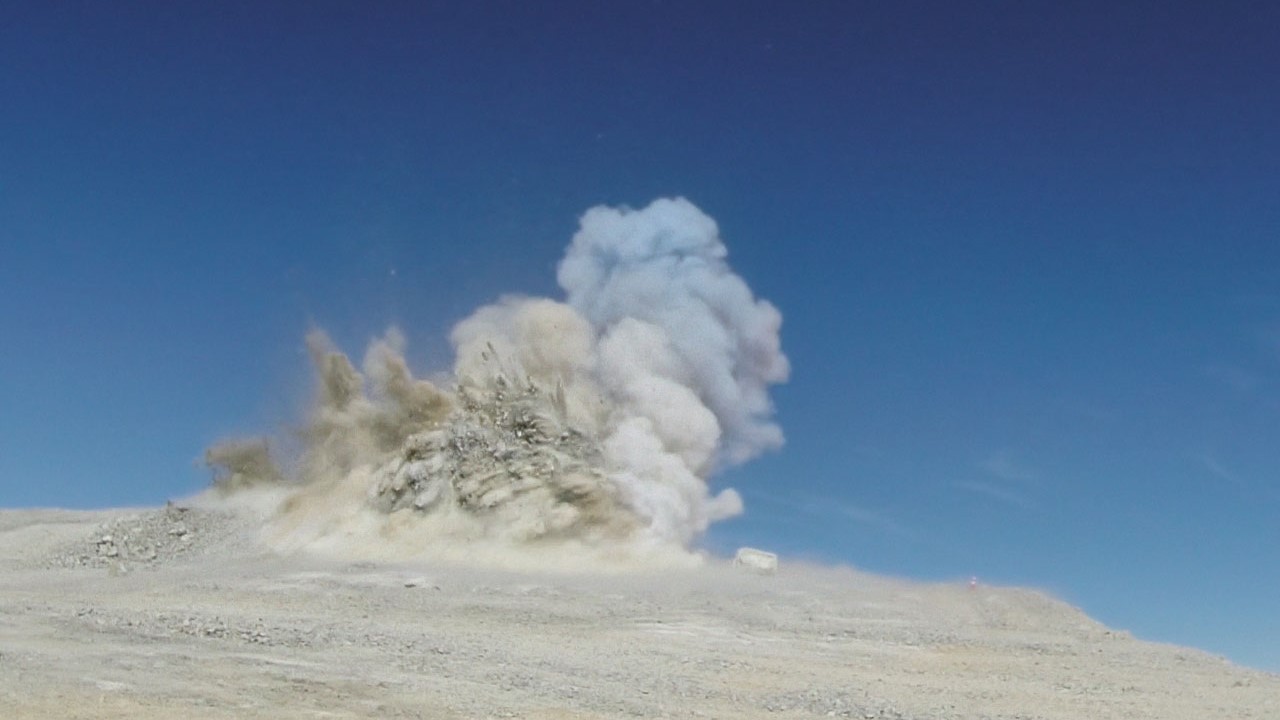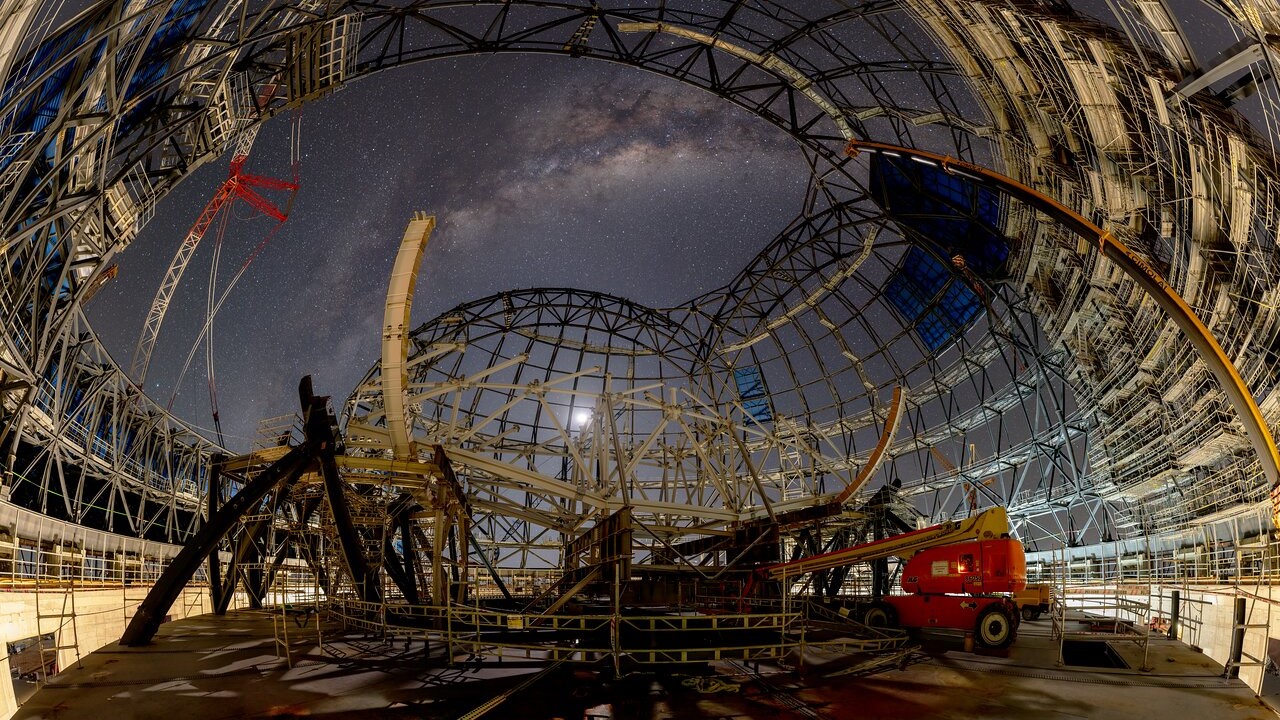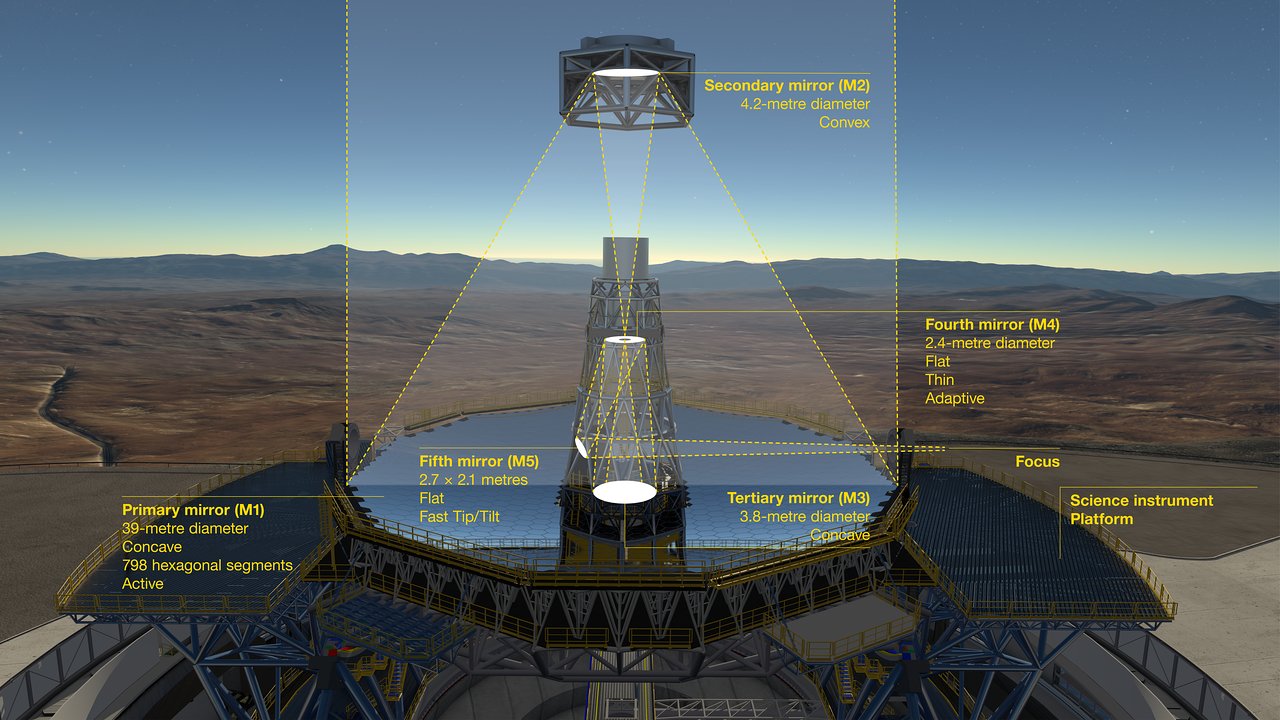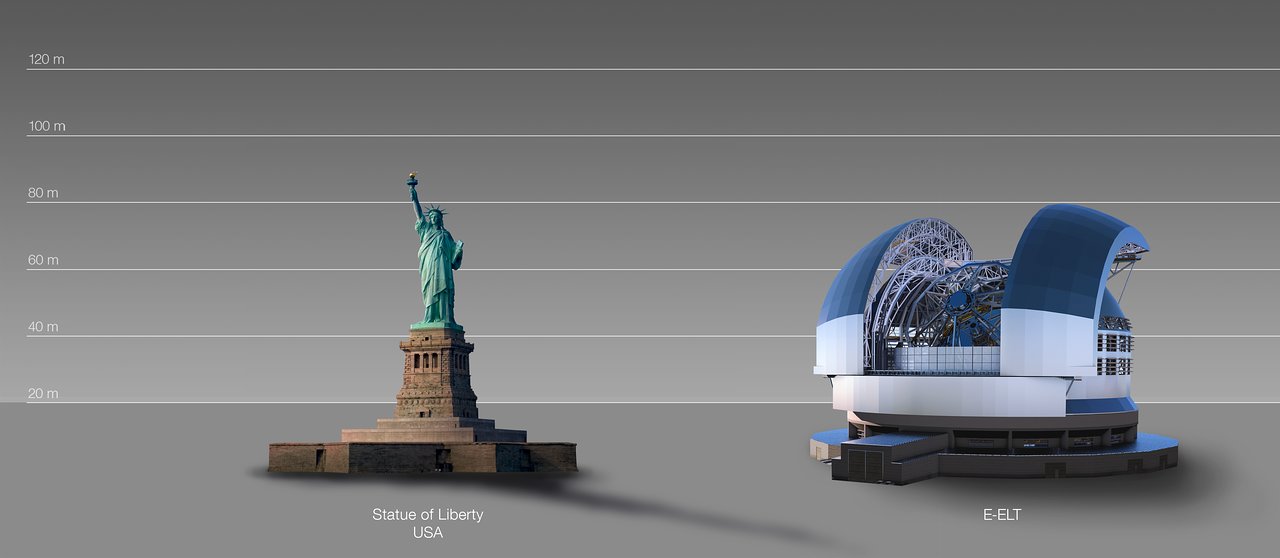The Extremely Large Telescope: Facts about the world's largest telescope
The world's largest telescope is being built on a mountaintop in Chile. It will be able to directly image rocky exoplanets.

The Extremely Large Telescope (ELT) will be the world's largest optical telescope, with a primary mirror that measures 128 feet (39 meters) across.
It is being built by the European Southern Observatory (ESO) in Chile at a cost of 1.3 billion euros (around$1.4 billion) and will be capable of detecting — and possibly even imaging — terrestrial planets in the habitable zones of other stars.
Where is the Extremely Large Telescope located?
The ELT is under construction atop Cerro Armazones, which is a mountaintop in Chile's Atacama Desert. The mountain is about 12 miles (20 kilometers) from the ESO's Very Large Telescope, which sits atop another Chilean mountain, Cerro Paranal. Cerro Armazones once stood 10,052 feet (3,064 m) above sea level, but in June 2014, the top was blasted away to level the mountaintop for construction, shaving 60 feet (18 m) off its height.
Cerro Armazones was selected as the location for the ELT because of its excellent atmospheric and climatic conditions. Earth's atmosphere is not friendly to astronomical observations; when you see stars twinkling, it is because turbulence in the atmosphere from winds and areas of higher and lower pressure and density result in a scintillating effect on the starlight. Water vapor in the atmosphere can also absorb light, particularly in the near-infrared, while dust can redden the light of stars and galaxies. Therefore, professional observatories such as the ELT are built on high mountaintops to get above as much of the atmosphere as possible.
The sky above Cerro Armazones is extremely dry; there is very low precipitable water vapor content, resulting in an annual rainfall of just 4 inches (10 centimeters). Because it is far from towns and cities, Cerro Armazones is also exceptionally dark, with the only light pollution being on the northwestern horizon from the coastal city of Antofagasta, 22 miles (36 km) away, and a few very distant mines.
How big is the Extremely Large Telescope's mirror?
The ELT's primary elliptical mirror has a diameter of 128 feet (39 m). Rather than being a single slab of glass, it is made up of 798 hexagonal segments, each of which is 5 feet (1.5 m) across and 2 inches (5 cm) thick. A further 133 segments are also required to allow segments to be removed, cleaned and recoated, as well as an additional 18 to replace any segments that become damaged.
In all, 949 segments have been produced, and all of these were completed in June 2024 by the German optics company Schott. The segments were then sent to optics company Safran Reosc in France for polishing to an accuracy of within 10 nanometers, which is less than one-thousandth the width of a human hair.
Breaking space news, the latest updates on rocket launches, skywatching events and more!
In addition to the primary mirror, which is designated M1, there are three other mirrors. The secondary mirror, M2, is 13.9 feet (4.25 m) in diameter. Schott described its production as a "huge challenge, requiring the grinding of raw material down to just 10 cm or 3.94 inches in thickness."
In the ELT's optical design, light is collected by the primary mirror and reflected onto the convex secondary mirror, which bounces the light onto a 21.1-foot (3.7 m) tertiary mirror (M3) through a hole in the fourth, 7.9-foot (2.4 m) adaptive optics mirror (M4), which then receives the light when reflected back by M3. Finally, M4 redirects the light to a fifth mirror, which focuses the light for the instruments.
What are the Extremely Large Telescope's adaptive optics?
On its high perch, the ELT is above much of Earth's turbulent atmosphere and water vapor, but it is not above all of it. This means its vision is still subject to atmospheric scintillation, which limits the telescope's resolution to about half an arc second (an arc second is 1/3600 of an angular degree in the sky) — no better than a good backyard telescope. To solve this problem, a technology called adaptive optics was invented and began to be used on large professional telescopes in the 1990s.
Adaptive optics works by firing a laser into the sky to excite sodium atoms high up in the atmosphere, causing them to glow and create an artificial "star." Computers then monitor the scintillation of this artificial guide star, and thousands of actuators move a telescope's mirror by degrees of just nanometers, constantly changing the mirror's shape to account for the twinkling and cancel it out so the view becomes crystal clear. (Alternatively, a bright star can do the same job as an artificial star, but there's not always a bright star in the direction in which the telescope is looking.)
The ELT uses a dual adaptive-optics system. The first level is provided by the fourth mirror, which is the largest adaptive mirror ever constructed. It contains more than 5,000 actuators that can change M4's shape thousands of times per second as light from distant galaxies, nebulae and exoplanets fluctuates in Earth's atmosphere.
The next level is a system called MORFEO (formerly known as MAORY), which stands for "Multiconjugate adaptive Optics Relay for ELT Observations." It consists of two deformable mirrors in addition to M4 to adjust for turbulence at three different atmospheric altitudes and will work in conjunction with a near-infrared instrument called MICADO (Multi-AO Imaging Camera for Deep Observations) and one other spectrographic instrument yet to be confirmed. The MORFEO-MICADO combination is designed to study galaxies as they looked up to 11 billion years ago.
Both M4 adaptive optics and the MORFEO system will utilize sodium laser guide stars, which ring the primary mirror and will form a circle of artificial stars in the sky around the celestial target of interest.
Why is the ELT so large?
Although there are different telescope designs, they all work according to the same guiding principle: The larger a telescope's mirror is, the more light it can gather. This means that the larger a telescope is, the fainter the objects it can see and the finer the details it can detect. At 39 m across, the ELT will be able to see fainter objects than any other optical telescope on Earth, in greater detail than any other telescope.
Compare this to the current largest single optical telescope in the world, the Gran Telescopio Canarias in Spain's Canary Islands. According to the ESO, the ELT will gather 15 times more light than the Gran Telescopio Canarias and provide views 15 times sharper than the Hubble Space Telescope. The diameter of the ELT's mirror is defined by its primary science drivers: to directly image terrestrial exoplanets, to characterize their atmosphere, and to measure the expansion of the universe, which is being accelerated by dark energy. It needs to be 39 m to accomplish these goals.
What are the Extremely Large Telescope's science objectives?
There are eight main science areas that the ELT will focus on: the solar system; exoplanets; stars; black holes; galaxies; cosmology and dark matter; fundamental physics; and unexpected discoveries.
First up is the ELT's planned studies of the solar system. The ELT will probe the atmospheres of the gas giants, as well as study volcanism and cryovolcanism on the moons of Jupiter and Saturn. It will also capture the spectra of asteroids in the asteroid belt and distant frozen objects in the Kuiper Belt.
The ELT will also look at exoplanets. In addition to having a large aperture for imaging rocky planets in the habitable zones of their stars, it will spectroscopically characterize the atmospheres of these potentially habitable exoplanets, particularly those set to be discovered by the European Space Agency's PLATO (Planetary Transits and Oscillations of Stars) mission, which is scheduled to launch in 2026.
The ELT's Armazones High Dispersion Echelle Spectrograph (ANDES) will be capable of detecting biosignatures — water vapor, oxygen and methane — in the atmospheres of such worlds. The ELT will also be adept at studying planet formation in dusty disks around young stars and, with its Mid-infrared ELT Imager and Spectrograph (METIS), could even detect moons forming around planets.
In addition, the ELT will probe star formation — not only in the present but also in the past, chronicling the star-forming history of the universe. The ELT website describes such measurements as "critical to understanding the link between dark matter and visible matter," since dark matter draws in visible matter, enabling it to form stars faster. The ELT will also chase down supernovas and the sources of gamma-ray bursts, as well as study the chemistry, in the form of heavy elements, created by these stellar explosions.
Supernovas and gamma-ray bursts are thought to form black holes. These are described as "stellar-mass" black holes, and the ELT will study the population of these black holes, as well as intermediate-mass black holes with between 100 and 10,000 times the mass of the sun and supermassive black holes with millions or billions of solar masses found at the centers of galaxies, including the Milky Way.
In particular, the ELT will seek to characterize Sagittarius A*, the supermassive black hole at the heart of our galaxy, using the orbits of stars that pass very close to the black hole. One key instrument on the ELT to help it achieve these observations of black holes will be the High Angular Resolution Monolithic Optical and Near-infrared Integral Field Spectrograph (HARMONI).
Black holes play a key role in the evolution of their host galaxies. As with star formation, the ELT will also study the evolution of galaxies throughout cosmic history, tracking down some of the extremely distant galaxies that the James Webb Space Telescope is finding and that existed just a few hundred million years after the Big Bang. The ELT will also explore the cores of galaxies — not just the black holes but also their nuclear star clusters, which are dense agglomerations of stars that surround the black hole.
On the grandest scale, there is the cosmology of our seemingly dark universe — one dominated by dark matter and especially by dark energy — which may require new fundamental physics to explain them. The extremely high-resolution observations made by the ELT will be able to detect behavior in the expansion of the universe or in the light of stars and galaxies that might hint at new fundamental physics or evidence of changes in the behavior of the fundamental constants of nature, such as the speed of light and the proton-to-electron mass ratio. A lot of the ELT's cosmological studies will be conducted with ANDES.
Finally, the ELT may make many unexpected discoveries. The telescope will be capable of seeing things no human has ever seen and of observing familiar objects in a level of detail never achieved. When scientists do this, they often discover new things that nobody ever expected, like the discovery of dark energy by astronomers using the Hubble Space Telescope in 1998 and the finding of hot-Jupiter exoplanets in 1995. Who knows what the ELT will discover?
What is the ELT's progress, and when will it be finished?
The first stone of the ELT was ceremonially laid in May 2017, and construction on the giant telescope dome, which will stand about 262 feet (80 m) tall when complete, passed the halfway point in July 2023. As of July 2024, the last segment of the primary mirror had been delivered by Schott for polishing before being delivered to the ELT Technical Facility at ESO's nearby Paranal Observatory. ESO's timeline now plans on the mirror segments being installed by 2027 and first light being achieved by 2028. A period of testing, calibration and verification then needs to occur, with the aim to begin science operations by the end of the decade.
Additional resources
Read about the scientific motivation for building the Extremely Large Telescope in these resources from ESO. Learn more about two other planned giant telescopes in a similar class to the ELT: the Thirty Meter Telescope and the Giant Magellan Telescope.
Bibliography
ESO, ‘Funding Boost for ESO's Extremely Large Telescope', 4 December 2020, https://www.eso.org/public/announcements/ann20034/
European Southern Observatory, ELT: Location, https://elt.eso.org/about/location/
ESO, ‘Groundbreaking for the E-ELT', 19 June 2014, https://www.eso.org/public/news/eso1419/
ESO, E-ELT Site Selected, 26 April 2010, https://www.eso.org/public/news/eso1018/
IPAC–JPL, ‘Cool Cosmos: Why Do The Stars Twinkle', https://coolcosmos.ipac.caltech.edu/ask/210-Why-do-the-stars-twinkle-
Maša Lakićević et al, ‘Atmospheric Conditions at Cerro Armazones Derived from Astronomical Data', 588, A32 (2016), https://www.aanda.org/articles/aa/full_html/2016/04/aa27973-15/aa27973-15.html
Julio C. Marin, Diana Pozo and Michel Cure, ‘Estimating and Forecasting the Precipitable Water Vapor for GOES Satellite Data at High Altitude Sites', Astronomy & Astrophysics, 573, A41 (2015) https://www.aanda.org/articles/aa/full_html/2015/01/aa24460-14/aa24460-14.html
M. Schöck et al, ‘Thirty Meter Telescope Site Testing I: Overview', Publications of the Astronomical Society of the Pacific', Vol 121, Number 878 (2009), https://iopscience.iop.org/article/10.1086/599287
ESO, ‘Last Segment of the World's Largest Telescope Mirror Successfully Delivered', 27 June 2024, https://www.eso.org/public/news/eso2410/
SCHOTT, 'Mission completed: SCHOTT produces final segment blanks for world's largest telescope mirror in ESO ELT', 27 June 2024, https://www.schott.com/en-si/news-and-media/media-releases/2024/schott-produces-final-segment-blanks-for-worlds-largest-telescope-mirror-in-eso-elt
European Southern Observatory, ‘First segments of the world's largest telescope mirror shipped to Chile', 19 December 2023, https://www.eso.org/public/news/eso2319/
SCHOTT, Extremely Large Telescope, https://www.schott.com/en-si/about-us/references/extremely-large-telescope
The ELT Construction Proposal, https://www.eso.org/sci/facilities/eelt/docs/e-elt_constrproposal.pdf
Claire Max, Introduction to Adaptive Optics and its History, AAS 197th Meeting (2001), http://hoffman.cm.utexas.edu/courses/History_AO_Max.pdf
G. Fiorentino et al, ‘MAORY Science Cases White Book', 2019, https://arxiv.org/abs/1712.04222
ESO, ELT: Mirrors and Optical Design – M4 Mirror, https://elt.eso.org/mirror/M4/
Max Planck Institute for Extraterrestrial Physics, MICADO, https://www.mpe.mpg.de/ir/micado
M. Gaug and M Doro, 'Impact of Laser Guide Star facilities on neighbouring telescopes: the case of GTC, TMT, VLT, and ELT lasers and the Cherenkov Telescope Array', Monthly Notices of the Royal Astronomical Society, Vol 481, issue 1, pages 727–748 (2018) https://academic.oup.com/mnras/article/481/1/727/5069412
ESO, ELT: FAQ question 15, ‘Why is the ELT a 39m Telescope?', https://elt.eso.org/about/faq/#question_15
ESO, ELT: FAQ, question 21, ‘https://elt.eso.org/about/faq/#question_21
ESO, ‘Science with the ELT', https://elt.eso.org/science/
ESO, ‘Science with the ELT: Solar System', https://elt.eso.org/science/solarsystem/
Sascha P. Quanz et al, ‘Direct Detection of Exoplanets in the 3–10 μm Range with E-ELT/METIS', International Journal of Astrobiology, Vol 14, issue 2 (2015) https://www.cambridge.org/core/journals/international-journal-of-astrobiology/article/direct-detection-of-exoplanets-in-the-310-m-range-with-eeltmetis/FF4F11F8023EFB19D14A5F78F5808132
Stephane Udry et al, ‘Exoplanet Science with the European Extremely Large Telescope. The Case for Visible and Near-IR Spectroscopy at High Resolution' (2014), https://arxiv.org/abs/1412.1048
A. Marconi et al, ‘ANDES, the High Resolution Spectrograph for the ELT: Science Goals, Project Overview and Future Developments,' (2024) https://arxiv.org/abs/2407.14601
Hannah Jang-Condell et al, ‘Protoplanetary Disk Science Enabled by Extremely Large Telescopes', Bulletin of the AAS: Astro2020 Science White Papers, Vol 51, issue 3 (2020), https://baas.aas.org/pub/2020n3i346/release/1
N. Oberg et al, ‘Observing Circumplanetary Disks with METIS', Astronomy & Astrophysics, 670, A74 (2023), https://www.aanda.org/articles/aa/full_html/2023/02/aa44845-22/aa44845-22.html
ESO, ‘Science with the ELT: Stars', https://elt.eso.org/science/stars/
Dieu D. Nguyen, Michele Cappellari, Miguel Pereira-Santaella, ‘Simulating Supermassive Black Hole Mass Measurements for a Sample of Ultramassive Galaxies Using ELT/HARMONI High-Spatial-Resolution Integral-Field Stellar Kinematics', Monthly Notices of the Royal Astronomical Society, Vol 526, Issue 3, pp3548–3569 (2023), https://academic.oup.com/mnras/article/526/3/3548/7308875
B. Garćia-Lorenzo et al, ‘HARMONI View of the Host Galaxies of Active Galactic Nuclei Around Cosmic Noon', Astronomy & Astrophysics, Vol 659, A79 (2022), https://www.aanda.org/articles/aa/abs/2022/03/aa41400-21/aa41400-21.html
ESO, ‘Science with the ELT: Galaxies', https://elt.eso.org/science/galaxies/
M. Gullieuszik et al, ‘Probing the Nuclear Star Cluster of Galaxies with Extremely Large Telescopes', Astronomy & Astrophysics, Vol 568, A89 (2014), https://www.aanda.org/articles/aa/abs/2014/08/aa24279-14/aa24279-14.html
C. J. A. P. Martins, ‘Fundamental Cosmology in the E-ELT era: The Status and Future Role of Tests of Fundamental Coupling Stability', General Relativity and Gravitation, Vol 47, 1843 (2014), https://link.springer.com/article/10.1007/s10714-014-1843-7
ESO, ‘Science with the ELT: Cosmology and Dark Matter' https://elt.eso.org/science/fundamentalphysics/
ESO, ‘Science with the ELT: Fundamental Physics', https://elt.eso.org/science/cosmodm/
C. J. A. P. Martins et al, ‘Cosmology and Fundamental Physics With the ELT-ANDES Spectrograph', Experimental Astronomy, Vol 57, 5 (2024) https://link.springer.com/article/10.1007/s10686-024-09928-w
ESO, ‘Science with the ELT: Unexpected Discoveries', https://elt.eso.org/science/discoveries/
ESO, ‘First Stone Ceremony for ESO's Extremely Large Telescope', 26 May 2017, https://www.eso.org/public/news/eso1716/
ESO, ‘ELT Telescope: Dome', https://elt.eso.org/telescope/dome/
ESO, ‘ESO's Extremely Large Telescope is Now Half Completed', 11 July 2023, https://www.eso.org/public/news/eso2310/
ESO, ‘Last Segment Blank of the World's Largest Telescope Mirror Successfully Delivered', July 2024, https://www.eso.org/public/news/eso2410/
ESO, ‘ELT: Timeline', https://elt.eso.org/about/timeline/

Keith Cooper is a freelance science journalist and editor in the United Kingdom, and has a degree in physics and astrophysics from the University of Manchester. He's the author of "The Contact Paradox: Challenging Our Assumptions in the Search for Extraterrestrial Intelligence" (Bloomsbury Sigma, 2020) and has written articles on astronomy, space, physics and astrobiology for a multitude of magazines and websites.







